Analogue vs Digital Multimeter - understand the pros & cons
Digital multimeters, DMMs are the main type in use today, but are analogue multimeters are still useful: I took a look at their relative advantages & disadvantages.
Multimeter Tutorial Includes:
Test meter basics
Analogue multimeter
How does an analogue multimeter work
DMM digital multimeter
How a DMM works
DMM accuracy & resolution
DMM CAT ratings
How to buy best digital multimeter
Cheap vs expensive DMM
How to use a multimeter
Voltage measurement
Current measurements
Resistance measurements
Diode & transistor test
Fault finding transistor circuits
Analogue vs Digital multimeter
Test leads & probes
Multimeters are the basic item of test equipment that everyone in electronics uses, whether professional or hobbyist.
These multimeters measure the three basic parameters of current, potential difference and resistance: amps, volts and ohms, giving their name to the first type of multimeter ever made: the AVO.
There are two main types of multimeter: analogue multimeters built around traditional meters and analogue components, and digital multimeters, or DMMs which as their name implies use digital technology.

Often the question about which is best can be asked as both types work well, but is one type better than the other, or are the different types suited to different situations.
Today the "go-to" type is the digital multimeter, but sometimes there may be an analogue emter available, or people may ask whether they are still relevant. Accordingly, I took a look at both types to see what their different advantages and disadvantages are.
Analogue multimeters
Analogue multimeters have been the workhorse of electricians and hobbyists for decades and they were one of the first forms of test instrument that became available.
These analogue multimeters use analogue meters that feature a needle that deflects across a calibrated scale, indicating the measured value.
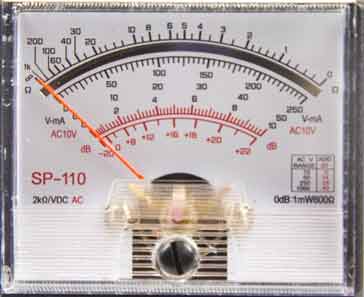
While is seemingly simple, analogue multimeters incorporate some very accurate electronics. They also provide some excellent advantages.
Response: The needle reacts relatively quickly to changes in the measured value - certainly the meter starts to move and give a broad indication faster than most DMMs will finish their count. This allows for observing fluctuations in voltage, current, or resistance. This is particularly valuable for troubleshooting circuits with dynamic behaviour.
Varying signals: On a similar thought line to the response time, analogue meters are much better at following signals, voltages etc that vary, such as audio, etc. The meter needle follows the level and it can be very useful for adjusting measurements for a peak, etc. The trend can easily be seen and the peak, etc, discovered more easily. Digital meters would often not be able to provide a usable reading under these circumstances. Analogue meters are also useful for varying signals like audio level meters.
Battery not needed for volts & amps measurements: If you don’t need resistance measurements then the analogue meters can be used without any need for a battery. A battery is needed for resistance measurements as some form of power is needed to drive current through the item under test. This contrasts with digital multimeters that need a battery for all tests. [Note: if not using a meter for some while, then it is best to remove it to prevent battery leakage and resultant damage].
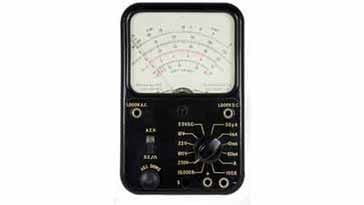
As with any technology, there are some disadvantages or aspects where analogue multimeters have their limitations.
Accuracy: While often accurate enough for many applications, analog multimeters can be less precise than digital ones. The interpretation of the needle's position can be subjective, especially on scales with small graduations. Parallax error, where the viewer's angle affects the perceived position of the needle, can also introduce slight inaccuracies.
Limited Functionality: Basic analog multimeters typically measure voltage, current, and resistance. Some advanced models might offer additional functions like capacitance or frequency measurement, but these tend to be less common.
Complicated scales: The scales on analogue meters can be difficult to understand especially for those unfamiliar with them. Thye usually have many different sets of scales on the meter, and often some interpretation may be needed, multiplying the reading by 10, 100, etc. This can be very confusing for those not very familiar with analogue meter scales.
Reading Difficulty: In low-light conditions, reading the scale and interpreting the needle's position can be challenging. Additionally, some users might find it difficult to distinguish between closely spaced values on the scale.
Cost: Although very low end analogue multimeters are available, these tend to be the real bottom end of the market, and they are about the same cost as low end DMMs. Very few, if any, quality analogue multimeters are manufactured these days because the cost is very high. However, it is possible to sometimes obtain high quality second user analogue meters for a very little, but these are often old.
Circuit loading: Analogue multimeters do not have such a high input resistance as DMMs. Typically a good analogue multimeter will have a "sensitivity" or 20kΩ / V. This means that on a 10 volt range, its input resistance will be 10 x 20kΩ = 200 kΩ A typical DMM will have an input resistance of 10MΩ or more.
Although not a disadvantage, it is important not to have any parallax errors - the needle and calibration should be viewed from above.
Some analogue multimeters - and other analogue meters - may have a mirror underneath the needle. when the reflection of te meter needle and the needle itself align, then this means that you are directly above the meter and there will be no parallax errors and accurate readings will be obtained.
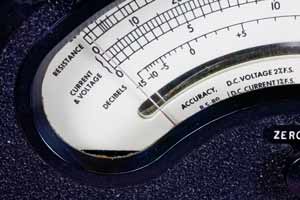
This offset view shows the reflection of the meter needle and how this can lead to reading errors.
Despite the fact that analogue meters have their disadvantages, they can still be very useful in many areas, and indeed they were the only form of multimeter and were very successful and useful for many years.
Digital Multimeters
Digital multimeters have become increasingly popular due to their advanced features and ease of use. They display the measured value on a digital display, eliminating the need for interpretation.
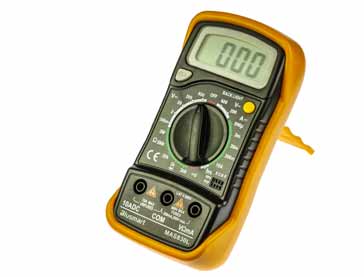
Digital multimeters offer several benefits:
Accuracy: Digital multimeters boast higher accuracy compared to their analog counterparts. The digital display provides a clear and precise reading, minimizing the possibility of human error.
Wide Range of Functions: Modern digital multimeters offer a plethora of functions beyond basic voltage, current, and resistance measurements. These can include capacitance, inductance, frequency, duty cycle, trueRMS, peak, temperature and often more. This versatility makes them a one-stop shop for various electronic troubleshooting needs.
Ease of Use: The digital display is easy to read, even in low-light conditions. Many models also come with features like backlight, auto-ranging, and data hold functions that further enhance user experience.
High input resistance: A typical DMM will have a very much higher input resistance than an analogue meter, meaning that it will not load the circuit uder test as much.
Data Recording: Some advanced digital multimeters allow for data recording and storage. This can be helpful for documenting measurements and analyzing trends over time.
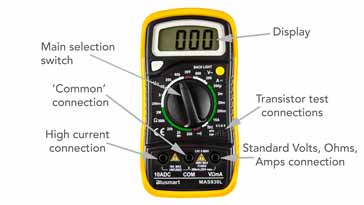
Like analogue meters, digital multimeters or DMMs also have their own set of disadvantages or drawbacks:
Complexity: With a wider range of functions, digital multimeters can be more complex to operate for beginners. Understanding the different settings and functions might require consulting the manual.
Slower Response: While still offering good response times, digital multimeters might not react as instantaneously to fluctuations in the level or any rapid changes in the measured value compared to an analogue meter. This could be a disadvantage when troubleshooting circuits with varying signals.
Requires a battery for any operation: As the digital multimeter uses various electronic circuits to make its measurements, drive the display, etc, a battery is required for any measurements to be made.
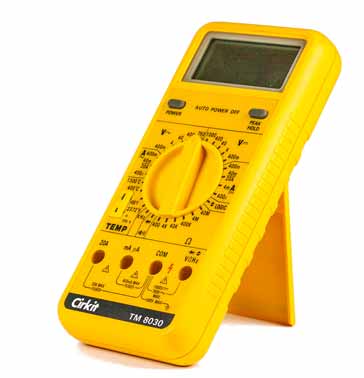
DMMs generally have a very much higher specification than their analogue counterparts - they fit in more with todays approaches and those new to electronics are more likely to grasp the way to use a DMM beter than an analogue meter. That said, analogue multimeters can still perform well and offer a much better reading format when anything needs to be adjusted, or if waveforms are slowly varying.
Both types of meter have their place, but the DMM offers better performance and is more aligned to todays, technology and techniques.
Choosing the Right Multimeter
Choosing the right multimeter might seem like a bit of a balancing act. The digital multimeters use much more up-to-date technology and it might seem like that is the obvious choice for all situations, but this may not always be the case.
While digital multimeters, DMMs do offer excellent performance, and most of them today measure parameters beyond the basic amps, volts and ohms of the analogue meters, there are times when the good old analogue meters may be more appropriate.
The ideal multimeter depends on your specific needs and priorities. Here's a breakdown to help you decide:
For Beginners: If you're just starting out with electronics or need a basic tool for occasional use, a low end digital multimeter is a good choice. These will give the basic amps, volts, and ohms and possibly some other measurements as well. Beware of using them on high voltages as they may not be fully qualified for high voltages despite the fact the ranges extend to 1kV or so.
For Professionals: Professional electricians and technicians working with complex circuits will benefit from the advanced features and higher accuracy offered by digital multimeters.
For Budget-Conscious Users: If cost is a primary concern, an analogue multimeter may be an option as some quality second user instruments can be bought - but beware they are old and calibration may have shifted slightly. Otherwise use a lower end DMM, but be aware of its limitations.
For Versatility: If you need a tool for a wide range of electronic projects and troubleshooting, a digital multimeter with a good selection of functions is the way to go.
Safety Features: Look for multimeters with built-in safety features like overload protection to prevent damage from accidental misuse. Also look for ones that are certified to be able to handle the top voltages - many low end meters are not and this can be a safety issue.
Auto-Ranging: Auto-ranging multimeters automatically select the appropriate measurement range, simplifying operation and reducing the risk of errors.
Portability: Consider the size and weight of the multimeter, especially if you need it for on-site work or projects requiring portability.
Ultimately, the best way to choose is to consider your individual needs and preferences. Experiment with both types of multimeters if possible. Regardless of your choice, remember to invest in a good quality multimeter from a reputable brand. A reliable tool will ensure accurate measurements and serve you well for years to come.
There are some further considerations that are worth investigating to make sure you select the best multimeter:
By carefully considering these factors, you can choose the right multimeter to become your trusted companion in the world of electronics.
 Written by Ian Poole .
Written by Ian Poole .
Experienced electronics engineer and author.
More Test Topics:
Data network analyzer
Digital Multimeter
Frequency counter
Oscilloscope
Signal generators
Spectrum analyzer
LCR meter
Dip meter, GDO
Logic analyzer
RF power meter
RF signal generator
Logic probe
PAT testing & testers
Time domain reflectometer
Vector network analyzer
PXI
GPIB
Boundary scan / JTAG
Data acquisition
Return to Test menu . . .




